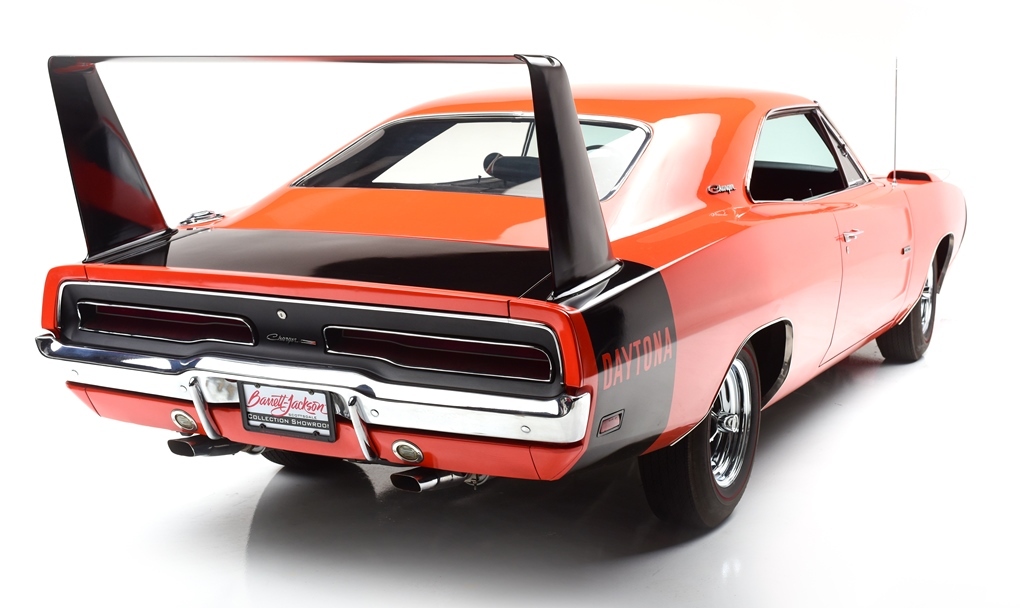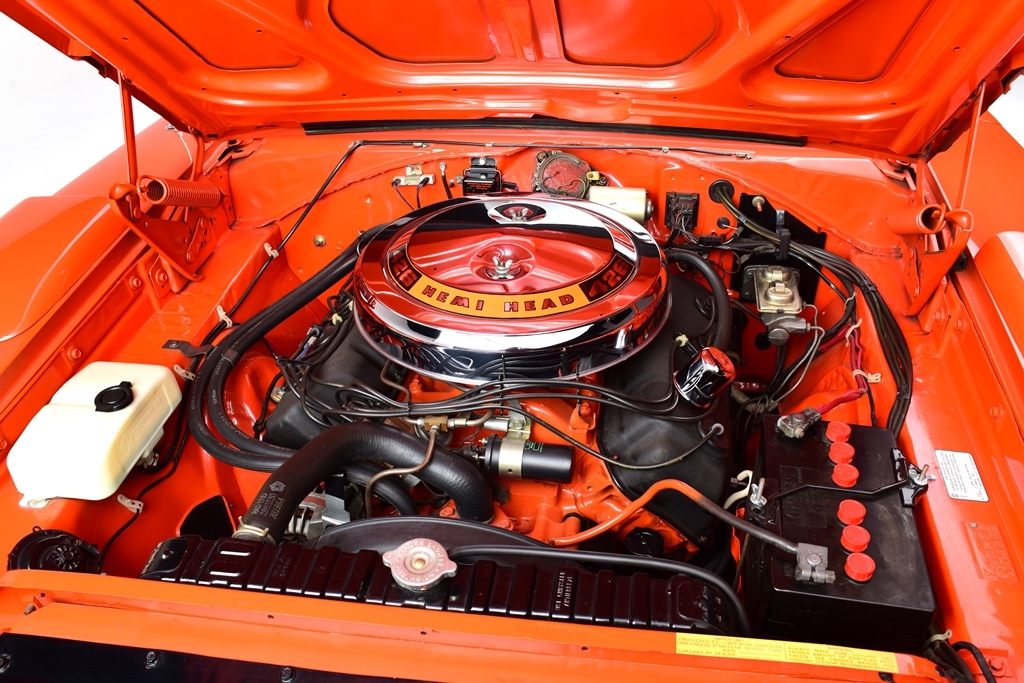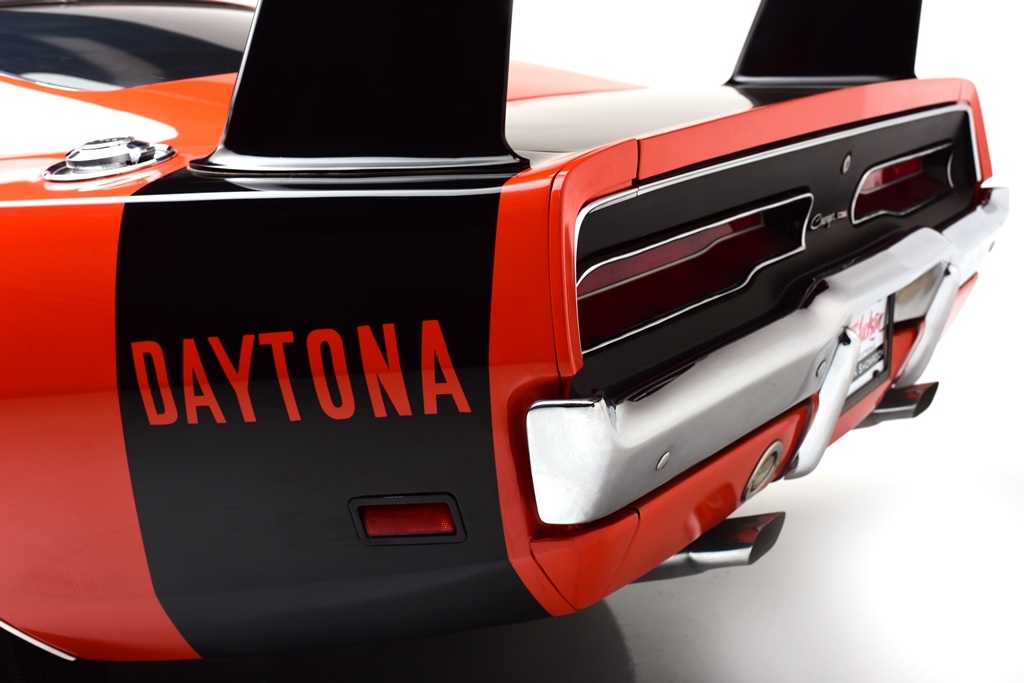Written by independent automotive journalist Steve Magnante
Since 1971, Barrett-Jackson has been one of the world’s premiere collector car auction houses. And while each year’s quartet of televised auctions sets records for attendance, sale prices and home viewership, it is important to remember that Barrett-Jackson maintains a showroom in its “hometown” of Scottsdale, Arizona. Stocked with a constantly rotating immediately available inventory of the world’s most desirable automotive treasures, the Barrett-Jackson Collection Showroom has one exceedingly rare muscle car on offer. One of the most sought-after Mopars on the planet – a fully documented, 31,000-mile 1969 Dodge Charger HEMI Daytona – could be yours.
 Dodge only built 503 Charger Daytonas in 1969. It was just enough to satisfy NASCAR’s mandate requiring Detroit carmakers to produce a minimum of 500 specialized vehicles prior to acceptance on the Grand National race circuit. Known as “homologation,” the minimum production scheme was meant to keep the “stock” in stock car racing. NASCAR knew its fans needed to relate to what they saw lapping the track or they’d lose interest. Fan appeal and vehicle relatability were at the core of the “race on Sunday, sell on Monday” concept.
Dodge only built 503 Charger Daytonas in 1969. It was just enough to satisfy NASCAR’s mandate requiring Detroit carmakers to produce a minimum of 500 specialized vehicles prior to acceptance on the Grand National race circuit. Known as “homologation,” the minimum production scheme was meant to keep the “stock” in stock car racing. NASCAR knew its fans needed to relate to what they saw lapping the track or they’d lose interest. Fan appeal and vehicle relatability were at the core of the “race on Sunday, sell on Monday” concept.
For the Charger Daytona, Dodge partnered with Creative Industries, an East Detroit specialty car builder, to transform semi-completed 1969 Charger R/Ts into winged warriors. But of those 503 Daytonas, the vast majority (433 cars) were powered by the base 440 Magnum. With its single four-barrel carburetor and wedge-type combustion chambers, the 375-horsepower 440 was Dodge’s primary street weapon during the muscle car era. But a NASCAR champion it was not. That job fell to the mighty 426 HEMI, of which only 70 were installed in 1969 Charger Daytonas.
 The pristine Charger Daytona showcased here is one of that ultra-rare breed. With its 727 TorqueFlite transmission and matching-numbers Street HEMI engine, the existence of this car legitimized Dodge’s multi-million dollar NASCAR program. Without the sale of this very Charger and its siblings, drivers like Bobby Isaac, Buddy Baker, James Hylton, Richard Brickhouse, Bobby Allison, Neil Castles and others couldn’t have established their reputations – or the reputation of the race-prepared HEMI Daytonas they piloted in over 30 NASCAR Grand National events, plus many more ARCA and USAC races.
The pristine Charger Daytona showcased here is one of that ultra-rare breed. With its 727 TorqueFlite transmission and matching-numbers Street HEMI engine, the existence of this car legitimized Dodge’s multi-million dollar NASCAR program. Without the sale of this very Charger and its siblings, drivers like Bobby Isaac, Buddy Baker, James Hylton, Richard Brickhouse, Bobby Allison, Neil Castles and others couldn’t have established their reputations – or the reputation of the race-prepared HEMI Daytonas they piloted in over 30 NASCAR Grand National events, plus many more ARCA and USAC races.
Of the 70 HEMI-powered Charger Daytonas built in 1969, 48 were equipped with the TorqueFlite automatic transmission seen in this beautiful, documented example. Sold new by Metro Dodge in Kansas City, Missouri, included paperwork shows it was delivered to the dealer on August 29, 1969 – a mere 16 days before the Daytona’s official NASCAR debut at the Talladega 500 on September 14, 1969. The frenzied nature of the Charger Daytona program called for all 503 cars to be delivered before the Talladega race or NASCAR wouldn’t allow them to compete. And remember, Dodge didn’t even announce the limited-edition Daytona until April 15, 1969 (a copy of the official announcement pamphlet comes with the car). But Creative Industries got the job done and built all 503 units in a three-month window.
 This example was initially constructed on June 3, 1969, at Dodge’s Hamtramck, Michigan, mega-factory as a stripe-delete HEMI Orange Charger R/T minus certain components that would be replaced during conversion. In keeping with the plan, it was then trucked approximately six miles to Creative Industries’ conversion facility in East Detroit, a small shop capable of handling only 20 cars or so per day. There the flush-mounted rear window, aluminum trunk spoiler, sheet-metal nose cone, chrome A-pillar molding covers and fender-top air extractor scoops were all installed.
This example was initially constructed on June 3, 1969, at Dodge’s Hamtramck, Michigan, mega-factory as a stripe-delete HEMI Orange Charger R/T minus certain components that would be replaced during conversion. In keeping with the plan, it was then trucked approximately six miles to Creative Industries’ conversion facility in East Detroit, a small shop capable of handling only 20 cars or so per day. There the flush-mounted rear window, aluminum trunk spoiler, sheet-metal nose cone, chrome A-pillar molding covers and fender-top air extractor scoops were all installed.
Repainted once in its life with a high-quality refinish, this HEMI Daytona is verified by the original Build Sheet and Trim Tag as being born wearing V2 HEMI Orange with a vibrant contrasting C6X black wing and interior. Applied to nearly 24 percent of the 1969 Daytona Charger fleet, the HEMI Orange body color is a constant reminder of the 425-horsepower HEMI under its hood. Inside, the original upholstery, equipment and trim is retained, and the solid, rust-free nature of the body panels and inner structures speak to a pattern of care and preservation among the few owners who have been fortunate enough to hold the title.
 The born-with HEMI is stock, and is complete with high-flow cast-iron exhaust manifolds and 2-1/2-inch H-pipe exhaust system. It even has the correct resonators straddling the gas tank. Built as an R/T, massive 11-inch manual drum brakes appear at each corner, while power-assisted steering eases arm strain when parking. Today, the odometer shows just over 31,000 miles, which is supported by the extensive DMV inspection records provided with the sale, along with a Build Sheet, receipts and the original factory warranty card. The car on offer has been personally inspected by acclaimed Mopar expert Dave Wise.
The born-with HEMI is stock, and is complete with high-flow cast-iron exhaust manifolds and 2-1/2-inch H-pipe exhaust system. It even has the correct resonators straddling the gas tank. Built as an R/T, massive 11-inch manual drum brakes appear at each corner, while power-assisted steering eases arm strain when parking. Today, the odometer shows just over 31,000 miles, which is supported by the extensive DMV inspection records provided with the sale, along with a Build Sheet, receipts and the original factory warranty card. The car on offer has been personally inspected by acclaimed Mopar expert Dave Wise.
Records show that Dodge lost almost $1,500 per car in the process of converting 503 Chargers into NASCAR homologation specials in 1969. But don’t feel too bad. Dodge’s loss could be your gain. The HEMI Charger Daytona stands as the most desirable Dodge B-body in existence. And with such a small number of the mere 70 cars built left intact, this authentic example is a once-in-a-lifetime opportunity to own an ever-appreciating piece of American muscle car history.
For more information on this outstanding muscle car, which is immediately available at the Barrett-Jackson Collection Showroom, click here.

